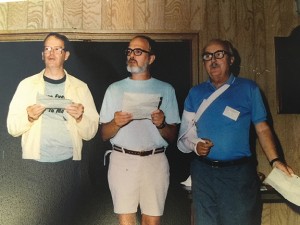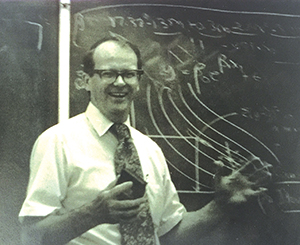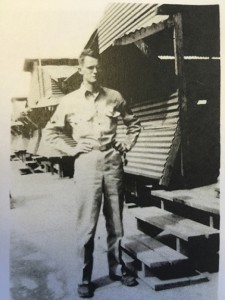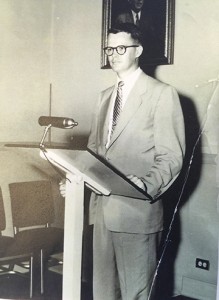Meet Mr. Rogers’ Roommate, a.k.a. Stu Hunter: A Statistics Legend
Amy Munice, ALM Communications
Most ASA members probably don’t think of Stu Hunter (J. Stuart Hunter) as a fellow who pulled strings for that hero of children’s television, Mr. Rogers, but he did.
Hunter’s storied professional credits define him as an influential statistician. He was founding editor of Technometrics, co-author of Statistics for Experimenters, and author of the statistics textbooks Design of Experiments and Statistics for Problem Solving and Decision Making, among others. He was also 1993 president of the ASA, a member of the National Academy of Engineering, and a Princeton University professor for nearly a half century.
Yet, talking to 92-year-old Hunter about his career milestones—perhaps because he is just the sort of ‘scoundrel’ he affectionately called his many young students and consulting associates through the years, or because he is too humble and modest to loudly blow his own horn—Hunter tells you, while chuckling, about the unexpected day when he came to pull strings for Mr. Rogers, instead.
They were roommates of sorts—Mr. Rogers and he—in the Pittsburgh television studios they shared, while each was recording the TV series for which they are famed. When you spend time in Mr. Rogers’ neighborhood and the electric train being used in the episode he’s filming doesn’t work properly, what do you do if not pull strings to make the train move?
True, Mr. Rogers may be the household name, but any statistics professor trying to bring the science alive for students owes it to them to watch Hunter’s black and white TV series on design of experiments, circa 1961, which you can find on YouTube today.
ASA Board Member and Williams College Professor of Statistics Dick De Veaux, who is one of so many Princeton University alumni who credit Hunter with first alerting them to the field of statistics, talks with reverence and deep affection about Hunter’s teaching techniques. “I had no interest or familiarity with statistics, but signed up for it because it was a requirement in engineering,” De Veaux recalled. “He was amazing—so engaging and making statistics come alive! After I took his first course, I took any course he was teaching each semester.”
De Veaux continued, “Today we have so many tools for teaching—interactive graphs and cool software—and he had none of that. All he had to work with were formulas and slide rules, and yet he made it exciting. He had so many real stories, for example as an early investigator of airbags, but no gimmicks like we have today.”
It is the report card on teaching by Princeton students that matters most to Hunter as he looks back on his career. “The undergraduates judged the classes they took and The Daily Princetonian printed the names of the top 10 professors in the school,” Hunter said recently. “I was on the list one or two times, and, on one occasion, I had two courses in the top 10. Statistics was not a popular course, but I was a popular teacher.”
JMP/SAS Principal Research Fellow Bradley Jones, who considers Hunter not only a professional colleague but also a friend and who has done joint lectures with Hunter in recent years, comments, “He commands the stage, using his body almost like a dancer to make his points. It’s a wonderful thing to watch and listen to.
“Giving a talk with him is great fun too. Once we gave a workshop seminar together where he would pick a topic from the beginning issues of Technometrics in 1959 through the 1980s in our joint research area of design of experiments. He’d talk about how you would accomplish it at first, and I’d then talk about how you could solve the same problems with modern software… . He likes to tell the story of how upset he was with me because, in graduate school, he had spent an entire weekend doing painstaking computations to invert a matrix that I could produce with modern software in just a few seconds.”
Even if you take computing for granted in your statistics work today, talk to Hunter and you too will likely be newly awed by how computers have changed the profession.
In 1941, just out of high school and with plans to someday be an attorney, Hunter got his first job with the Prudential Company working in their actuarial department where he did many calculations with IBM punch card computers. He then served in the Army in the Philippines during World War II, specializing in the calibration of heavy ordinance. The Army had earlier sent him to North Carolina State University for special training, and when he got out of the service he decided to return there for his bachelor’s in electrical engineering, in 1947, followed by a master’s degree in mathematics with a minor in statistics in 1949. During his studies, he worked part time, and then, upon graduating, full time for Gertrude Cox in the computing lab she had established at North Carolina State University.
Hunter says, “I can remember when the 602A IBM computer arrived. It was called a calculating punch, the first computer we had that could be programmed to multiply and divide numbers. Before that machine came, whenever we had to multiply we’d have to sort the cards and put them in an accumulator repeatedly. It took a long time just to get the sum of the squares!
“If I were teaching today, I’d be using statistical software, but that just didn’t exist in the 50s and 60s when I was teaching a class and making the videos for Westinghouse. For teaching tools on TV, I had a black felt board and pieces of cardboard that would stick on the felt. All computations were very humble. It’s a different world today when you consider the proliferation of statistical software and the availability of color graphics as teaching tools.”
Perhaps even more amazing to Hunter are the changes he has witnessed, and played a hand in creating, in worldwide industry. Hunter grew up in Linden, New Jersey, by the New Jersey Turnpike and not far from Newark Liberty International Airport. He says, “We lived in the shadow of oil refinery gas tanks and flare stacks. My father always said that we should never complain about the smell because it meant men were working.”
Later, after his PhD (1954) and before George Box invited him to Princeton in 1962, Hunter went to work for the American Cyanamid Co. as an in-house statistical consultant. After he became an academic, Hunter’s consulting practice expanded and grew so rapidly that he once quipped to De Veaux that he was forced to retire from teaching because he was too busy.

(Stu) Hunter, (Bill) Hunter, and (George) Box at the Gordon Conference singing “There’s no theorem like Bayes theorem.” Here are more pictures from this event
Hunter not only did consulting himself, but broke in many younger statisticians to do similar work, describing that aspect of his mentoring by saying, “If I had an afternoon off from teaching available to do consulting I’d invite guys like De Veaux to help me with the lectures. They were all high-energy young men and they also got paid, which they enjoyed a great deal. And I certainly enjoyed their company.”
The way De Veaux tells the story, it was actually Hunter who supplied the energy. De Veaux remembers, “One day in 1986 after I started teaching at Princeton, Stu comes into my office to show me his agenda book written with his very precise handwriting that you always remember. One week he had entries that said ‘Alcoa, Alcoa, Alcoa,’ and also ‘Ford, Ford, Ford.’ He then said to me, “I can’t do both. Which do you want?’ We decided on Alcoa, and then Stu calls Brad Novick, who headed statistics at Alcoa, and tells him he has a young associate whom he wants to do the job. Novick, of course, says ‘Are you kidding?’ and we were then put on a trial run working together. His mentorship meant so much to me—we worked together and separately on those consultations for almost 10 years.
“I remember another time when we were at Gordon conferences together and he tells me that we will have to miss Tuesday’s events. ‘Why?’ I asked. He then explains we have a consulting job with Scientific Instrumentation Labs. We were in Maine and, when that Tuesday arrived, someone came to pick us up at 6:15 in the morning to drive us to Boston. We had 20 groups, starting at 8 a.m., and it continued until 5:00 in the evening. A group would come in and tell us their issues, and then the next group would come in. Can you imagine a more intensive learning experience? Later, when they drove us back to the conference, he was still going! He’s the Energizer Bunny! We had been immersed in it for 12 hours by then and I was totally wiped out. That’s Stu.”
It wasn’t just American industry Hunter touched, but worldwide industry, and perhaps most significantly, Chinese, whose transformation to the industrial behemoth it is today can in part be traced back to Hunter, though he will tell you the change in China he helped bring about stuns him.
It wasn’t long after the famed Ping Pong games that opened a door in Chinese and American relations that Hunter nearly became Henry Kissinger’s roommate, too. Kissinger, who had been negotiating with China before Nixon’s arrival to officially thaw Chinese-American relations, had just vacated an apartment where Hunter stayed in 1980 and 1981 on his way to become a member of the National Center for Industrial Science and Technology Management Development in Dalian, China. Hunter explains, “The U.S. Department of Commerce had decided to create exchanges between Chinese and American industry. This included a five-week course on manufacturing processes for which they asked me to give lectures on quality control and applied statistics.
“For two summers, my wife and I traveled to Dalian, China. My wife was the first Western woman that many Chinese people had ever seen. Wherever she went, she’d attract crowds and people would try to touch her. They were respectful, but awed. Also, we had a refrigerator in our apartment. Many Chinese had never seen one of these, either, and they would come to our apartment to see it.
“The Dalian staff translated all my talks—some on statistics and some on design of experiments so that there was a textbook of my talks by the second year, and that’s how I came to have a Chinese textbook.”
While global travel is relatively commonplace today, it wasn’t when Hunter began teaching short courses. Lecturing became a passport of sorts, taking him to South Africa, Australia, Japan, New Zealand, Argentina, Sweden, and Korea. Sometimes he went alone, but he often took his wife and their three young children, who got to see parts of the world their peers could only imagine.
To this day, Hunter marvels at much of what he saw in these travels, such as South-African streets lined with semi-precious stones, discarded because they were near the prized diamond mines with the greater treasure. Or, also in South Africa, mines so deep the rocks were hot to the touch.
It’s been quite a career and it’s still going. This coming year, Hunter hopes to find an excuse to visit the JMP people in Raleigh, a favorite city where he met and married his wife. He’ll also be going to professional meetings in Seattle, and perhaps to the next Stu Hunter Research Conference, of which he says, “I had always complained about national meetings where there are hundreds of 20-minute presentations and no time for conversation during the sessions. The Gordon Conference meetings, in contrast, meet for a week in which there are only two to four papers a day. The speaker has an hour or so to give a talk, during which time he can be interrupted, and then there is a Q and A with debates. It’s very leisurely and much more enjoyable. I’m delighted that this new conference follows the Gordon model, though I really didn’t have anything to do with setting it up. It’s embarrassing that they named it after me when they could have named it after someone important like George Box.
An earlier version cited Hunter as being the 1992 ASA president. He was actually president in 1993.













This is all true and perfectly accurate. Stu Hunter is a wonderful, energetic speaker and teacher. We kept his well made point about time to discuss talks in a relaxed atmosphere when putting together the ASA Conference on Statistical Practice.
Hi Stu:
How did you get to be 92 ? Same way I got to be just shy of 90. The picture (recent?) makes you appear trim and vigorous, which I hope is the case.
You would be very welcome to come out to NPS and help recall our past
activities in statistics. You have always been a stimulating spokesman for
Statistics as a field, and a sturdy eloquent spokesman for LIFE.
Best,
Don Gaver
Stu is one of a kind. I had the very good fortune to have Stu as my advisor on my senior thesis in the Chemical Engineering Dept at Princeton during 1962-63 so I saw his magic and it led to a career in statistics for me and many others. For me it changed my career path and introduced me to other great mentors including Bill Hunter and George Box at the new Statistics Dept at the University of Wisconsin-Madison. This AMSTATNEWS article gives us a wonderful glimpse of a truly gifted member of our profession.
Stu was my senior thesis advisor in 1962-63, as Bill Hill and I were classmates and close friends. My thesis was “Parameter Estimation in Exponential Models: A Study in Non-linear Regression” done on the huge IBM machine, where you prepared the punch cards and put them in the machine at night, hoping it would run by the next morning. Stu was a great professor, I have warm feelings for him. I saw Stu at my 50th Reunion at Princeton in 2013.
I went on to law school after Princeton, and became a tax lawyer, and served in the second Reagan Administration as Assistant Secretary of the Treasury for Tax Policy for years 1985-87 under Treasury Secretary (and Princetonian) Jim Baker.
I have recently written a book, entitled “Tales of Tax Reform” that describes the process that led to the enactment of the Tax Reform Act of 1986. Stu, once it’s published I’ll send it to you (and to you, Bill, of course).
Keep going, Stu.
Roger Mentz Princeton 1963
Stu,
It’s a great pleasure to see this written about you. You remain one of my favorite people of all time. I would love to know more about how you are doing. I had some great conversations with Forman Acton about five years ago and tried to pass a message to you, but I guess it didn’t get through.
I’m glad to hear you are still around and kicking!
Cheers,
Gary Oleson
Princeton 1971
Welcome!
Amstat News is the monthly membership magazine of the American Statistical Association, bringing you news and notices of the ASA, its chapters, its sections, and its members. Other departments in the magazine include announcements and news of upcoming meetings, continuing education courses, and statistics awards.
ASA HOME
Departments
Archives
ADVERTISERS
PROFESSIONAL OPPORTUNITIES
FDA
US Census Bureau
Software
STATA
QUOTABLE
“ My ASA friendships and partnerships are some of my most treasured, especially because the ASA has enabled me to work across many institutional boundaries and
with colleagues from many types of organizations.”
— Mark Daniel Ward
Editorial Staff
Managing Editor
Megan Murphy
Graphic Designers / Production Coordinators
Olivia Brown
Meg Ruyle
Communications Strategist
Val Nirala
Advertising Manager
Christina Bonner
Contributing Staff Members
Kim Gilliam
Contact us
Amstat News
American Statistical Association
732 North Washington Street
Alexandria, VA 22314-1904
(703) 684-1221
www.amstat.org
Address Changes
Amstat News Advertising